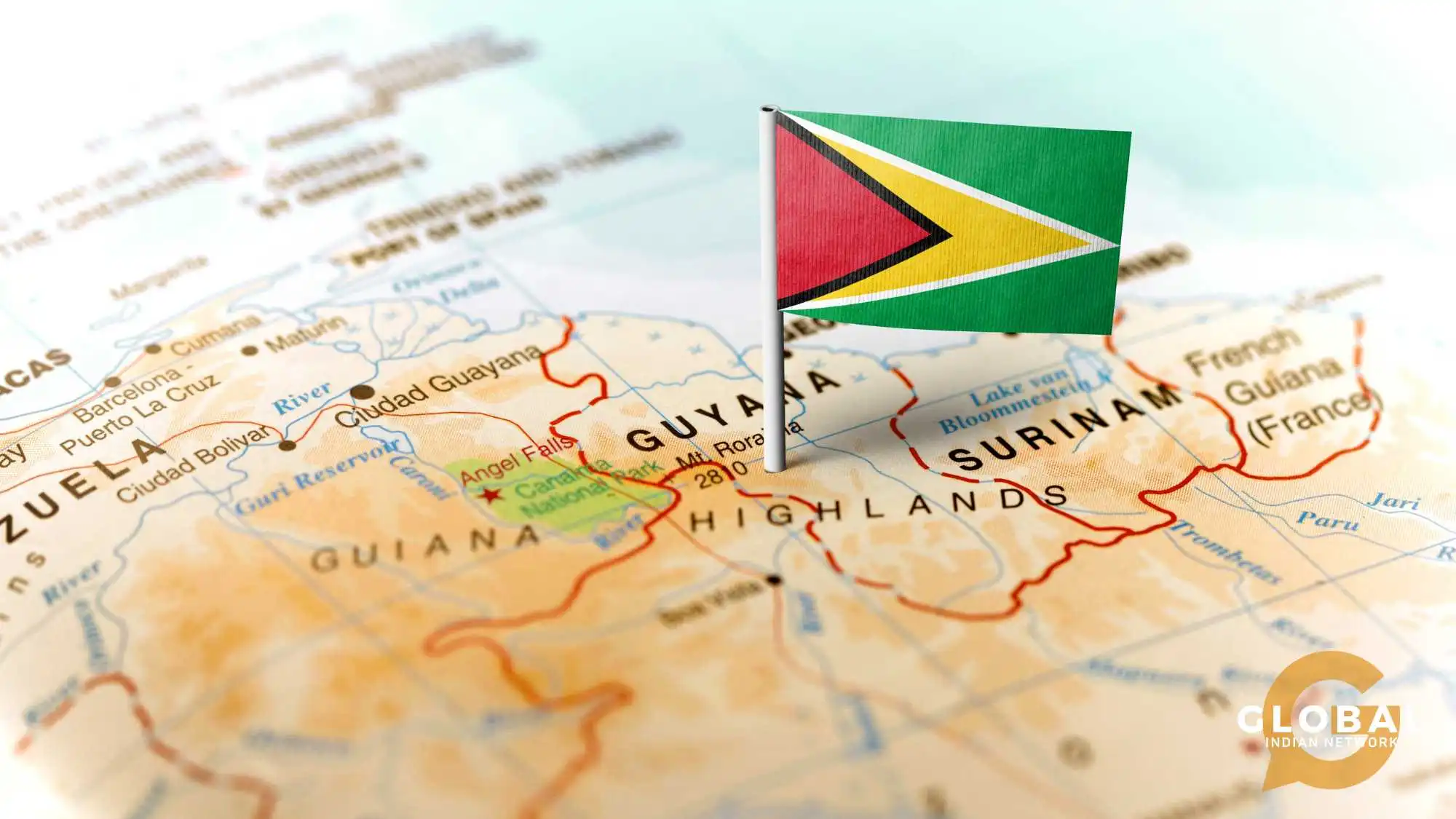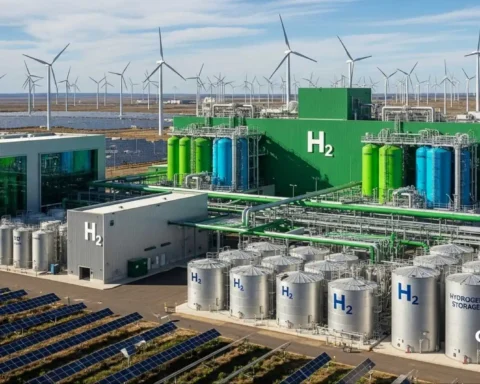The world rejoiced when they found oil in 1859 in the United States of America. Lives were going to change for the better. Time proved that the more oil a country had, the richer it got.
For a long time, the world has been running and is currently, mostly on the wheels of oil.
But how much oil is optimum? We bring this up since Guyana in South America, has been blessed with newfound oil in their waters.
Too much bounty – is it a boon or a bane? Let us find out.
This article explores the complexities of Guyana’s oil boom, debt crisis, and political and economic stability, highlighting both opportunities and challenges in this significant shift.
Table of Contents
Guyana – An Overview
Guyana, a northeastern South American country, is the only English-speaking country in the region, known for its pristine rainforests, sugarcane plantations, rice fields, and significant bauxite and gold reserves. Despite its natural wealth, Guyana was one of the poorest countries in South America until recent deepwater oil field discoveries in its offshore Stabroek Block significantly changed its economic fortunes.
Guyana’s political landscape is a presidential representative democratic republic, with the President as the head of state and government, and a unicameral, National Assembly parliament. The economy consists of agriculture, mining, forestry, and fishing, with oil and gas emerging as a significant sector, with the Guyanese dollar (GYD) as the currency.
The region boasts a rich cultural heritage, characterized by a mix of Indo-Guyanese, Afro-Guyanese, and Amerindian groups, and offers a variety of attractions including natural beauty and cultural heritage sites.

Oil Reserves and Boom
The oil boom, fueled by ExxonMobil’s discoveries, offers promising economic opportunities but also presents challenges in managing wealth, promoting sustainable development, and addressing rising debt. Guyana’s offshore basin, particularly the Stabroek Block, holds over 11 billion barrels of oil, potentially reshaping the nation’s fortunes due to its abundant crude oil resources.
GDP growth rate (Source: tradingeconomics.com)
The oil industry in Guyana has significantly boosted the economy, generating revenue, GDP growth, and job creation. This has led to investments in critical infrastructure, but also presents challenges like responsible wealth management, avoiding resource curse, and ensuring equitable distribution.
Guyana’s 2015 oil discovery led to significant economic growth, with real GDP growth in 2022 and 2023. However, concerns about the “resource curse” (details later) due to weak democratic institutions and ethnic divisions persist, necessitating responsible governance and oil wealth balance.
Debt Crisis and Challenges
Heavily Indebted Situation
Guyana’s government faces financial challenges due to heavy debt and the complexity of managing its oil wealth. Overspending ExxonMobil’s revenue could be tempting, especially given the potential for rapid economic growth.
The Resource Curse Looms
The “resource curse” is a dangerous cycle causing overreliance on oil, corruption, and ethnic divisions in commodity-rich nations. Guyana must avoid over-dependence and diversify its economy, ensuring transparent governance and accountability to prevent mismanagement of oil funds and ensure equitable distribution of oil wealth.
Political Implications and Geopolitics
Let’s delve into the political implications and geopolitical dynamics surrounding Guyana’s oil discoveries:
The Venezuela-Guyana Border Dispute
Venezuela and Guyana have been fighting over the Essequibo region since colonial times. The discovery of oil in disputed waters has escalated tensions, with Venezuela claiming the 1899 Arbitral Award invalid. Guyana sought international arbitration through UNCLOS, and in 2021, the Permanent Court of Arbitration ruled in favor of Guyana, affirming its sovereignty over the disputed area.
Guyana’s Strategic Alliances and Confidence in International Law
Guyana, a global player, has strong ties with the United States, supporting its sovereignty claims and promoting international law adherence. It has been a key partner in developing its oil sector and is committed to peaceful resolution through legal channels.

Guyana’s Debt Crisis
Guyana has been grappling with debt issues due to its historical debt accumulation, which increased from 1.2 billion in 1984 to 1.7 billion in 1987. Despite a decrease in public-sector debt from 57.7% to 42.9% in 2021, the country’s debt portfolio is exposed to exchange rate risk, particularly with foreign currency-denominated debt, which impacts costs and risks.
Stabroek Block and its Significance
The Stabroek Block, a 6.6 million acre offshore oil reservoir off Guyana’s Atlantic coast, is significant for its significant oil discoveries.
ExxonMobil announced the Liza Discovery in May 2015, the first significant oil find offshore Guyana. The Liza-1 well found over 295 feet of high-quality oil-bearing sandstone reservoirs, safely drilled to a depth of 17,825 feet in 5,719 feet of water.
The Stabroek Block, with its significant oil discoveries, has significantly impacted Guyana’s economy, attracting international attention and investment. However, it also presents challenges in responsible resource management and environmental impact.
Issues Faced by Guyana
Guyana faces several critical challenges after the discovery of its substantial oil reserves. Let’s explore these issues:
Resource Curse and Dutch Disease: The resource curse, a concern involving oil wealth, can lead to economic instability and political challenges. Guyana must avoid this trap by diversifying its economy to prevent overreliance on oil, as the Dutch disease phenomenon occurs when resource revenues inflate a country’s currency.
Ethnic Divisions and Social Impact: Guyana’s ethnically divided population necessitates equitable management of oil wealth to prevent tensions and ensure all citizens, regardless of ethnicity, receive the benefits of oil revenue. This delicate task is crucial to prevent exacerbating existing tensions and ensure the equitable distribution of oil revenue.
Climate Change and Environmental Responsibility: Guyana faces climate change threats due to its coastal vulnerability, necessitating a balance between oil production and environmental protection, addressing the ethical dilemma of drilling for more oil while aiming for climate goal
Institutional Capacity and Governance: Guyana’s oil revenues management lacks experience, necessitating the establishment of a sovereign wealth fund for transparent and responsible oil wealth management.

Contractual Agreements and Transparency: Guyana must honor contracts with oil companies while ensuring transparency and avoiding corruption, and should learn from other oil-producing nations’ governance practices.
In summary, Guyana’s path forward involves responsible management, equitable distribution, and environmental stewardship as it navigates its newfound oil wealth.
Resource Curse
The resource curse, also known as the poverty paradox, is a phenomenon where countries with abundant natural resources experience negative economic outcomes, such as lower economic growth, weaker democracy, and worse development outcomes. This phenomenon is not universal and applies to specific countries or regions under specific conditions.
Real-World Examples of a Resource Curse
Nigeria, Africa’s major oil producer, grapples with poverty, inequality, underdevelopment, corruption, economic volatility, insufficient investment, environmental degradation, and social unrest due to mismanaged oil revenues.
Venezuela, once the wealthiest Latin American nation, is grappling with economic instability, hyperinflation, and severe social and political crises due to over-reliance on oil exports, mismanagement, corruption, and lack of economic diversification.
The Democratic Republic of Congo, rich in cobalt, copper, and coltan, faces challenges in transforming its mineral wealth into development due to conflict, corruption, weak governance, and infrastructure.
Angola, despite its vast offshore oil reserves, is grappling with poverty, corruption, economic diversification, infrastructure development, and social services challenges despite its substantial oil revenues.
Saudi Arabia faces economic diversification challenges due to its heavy reliance on oil exports, making it susceptible to global oil price fluctuations.
Equatorial Guinea, Africa‘s top oil producer, faces poverty and income inequality due to corruption and mismanagement of oil revenues, despite widespread development and improved living standards.
Real-World Examples of Overcoming the Resource Curse
Let’s explore some real-world examples of countries that have successfully navigated the potential pitfalls of natural resource wealth, avoiding the “paradox of plenty”:
Botswana, Canada, Chile, and Norway have successfully managed their resource wealth through education, infrastructure, and good governance, resulting in sustained economic growth. Canada‘s robust governance prevents the resource curse, while Chile’s robust copper industry supports its economy through sound policies and prudent fiscal management. Norway’s sovereign wealth fund manages its oil wealth with transparency and accountability.
These examples demonstrate that with good governance and strategic policies, countries can turn resource abundance into sustainable development.

Dutch Disease
Dutch disease is an economic phenomenon where a resource boom leads to a decline in other sectors, such as manufacturing or agriculture. Originating in the Netherlands after 1959, it involves deindustrialization, increased demand for non-tradable goods, and currency appreciation, highlighting the challenge of managing wealth while maintaining a diversified economy.
The Dutch disease has two main economic effects: a rise in local currency due to resource exports, which reduces the competitiveness of manufactured goods in international markets, and a surge in foreign exchange, which may encourage imports, harm domestic industries, and contribute to unemployment as manufacturing jobs move to lower-cost countries.
Real-World Examples of Dutch Disease
Dutch disease is an economic phenomenon that occurs when the value of a nation’s currency spikes due to the discovery or exploitation of a valuable natural resource. Here are some real-world examples:
In the 1970s, Britain’s oil prices quadrupled, enabling North Sea oil drilling off Scotland. The pound’s value soared, but recession ensued due to uncompetitive exports and job losses. Canada’s oil sands exploitation led to an overvalued dollar and currency appreciation.
In 2014, Russia’s ruble appreciated due to oil-related capital inflows, similar to Canada. However, this trend eased in 2016 when oil prices dropped. Mexico and Indonesia experienced Dutch disease.
Remember, Dutch disease highlights the challenges of managing newfound wealth from natural resources while maintaining a diversified economy.
Real-World Examples of Successful Dutch Disease Mitigation
Canada’s interprovincial migration has mitigated Dutch disease effects from resource booms, with temporary foreign workers and migration playing a crucial role in offsetting the non-tradable sector’s impact. Market-driven immigration can counter Dutch disease by diversifying the labor force, reducing reliance on resource sectors, and promoting other industries.
Remember, each context is unique, and successful mitigation strategies depend on specific circumstances.

Effects of Dutch Disease
Diversification of Economic Base by Countries Beyond Natural Resources
Economic diversification is crucial for countries to decrease their reliance on natural resources and foster sustainable growth.
The initiative aims to boost growth in non-resource sectors like manufacturing, services, technology, and agriculture by investing in human capital, particularly education and skill development.
The strategy utilizes renewable natural capital and diversifies export markets to reduce commodity price fluctuations and provide indefinite benefits. The initiative aims to foster entrepreneurship and innovation by fostering a dynamic business environment and encouraging startups and small businesses to diversify the economy.
Remember, economic diversification enhances resilience and long-term prosperity. The adage ‘Don’t put all your eggs in one basket’ rings true.
Real-World Examples of Successful Economic Diversification
Here are some real-world examples of successful economic diversification:
Chile’s diverse economy exports over 2,800 products to 120 countries, while Germany, the US, and South Korea have high economic complexity and diverse product portfolios, achieving success through developed products.
Focusing on industries like healthcare, technology, telecommunications, and clean energy can foster job creation and promote sustainable diversification. Economic diversification is crucial for long-term growth and poverty reduction, and international cooperation is encouraged for technical assistance and knowledge sharing.
Guyana’s Economic Diversification Efforts
Guyana acknowledges the significance of economic diversification for long-term development and aims to mitigate risks linked to over-reliance on a single sector. Here are some key points about Guyana’s efforts:
Dutch Disease Concerns: Guyana’s oil sector growth has increased revenues, but the “Dutch Disease” phenomenon, where resource booms reduce incentives for non-resource tradable goods production, could negatively affect its international competitiveness.
Limited Linkages: Guyana’s mining sector, primarily bauxite and gold, had limited economic connections before oil production, and robust growth did not stimulate other sectors, indicating the need for further development.
Diversification Strategy: Guyana’s government is prioritizing economic diversification, reducing oil dependency, and combating Dutch Disease by fostering local linkages, promoting employment, investing in infrastructure, and closing investment gaps.
Agriculture and Fisheries: Investments in agriculture and fisheries, along with enhanced crop varieties, livestock breeds, and irrigation infrastructure, are being made to boost economic transformation.
Guyana is achieving sustainable prosperity and resilience through strategies such as diversification, infrastructure development, and sustainable resource management.

Challenges Faced During the Diversification Process
Economic diversification is a complex process, and several challenges can arise during its implementation.
Diversification in businesses can lead to market risks, resource strain, coordination issues, and focus diversion, necessitating effective organizational structures and leadership for effective management.
Policy coordination across sectors is crucial for diversification efforts, and a favorable investment climate in non-oil sectors requires regulatory reforms and increased investor confidence. Guyana faces challenges in international markets for non-oil exports, including regulatory hurdles, cultural differences, and established competitors.
Guyana faces challenges in constructing roads, ports, and utilities to support agriculture, tourism, and other non-oil sectors due to infrastructure gaps. Diversifying within an industry can potentially lead to cannibalization, where new products or services compete with existing ones, making it crucial to balance innovation with existing offerings.
Social equity is crucial for ensuring diversification benefits all citizens, especially vulnerable groups, and requires the implementation of social safety nets and inclusive policies
Opportunities for Guyana
Guyana’s oil wealth presents both challenges and opportunities, presenting both opportunities for sustainable development and poverty alleviation.
Oil revenues can be utilized to improve infrastructure, such as roads, ports, and telecommunications, which boost economic growth, attract investments, and create jobs. Additionally, investing in education and skills development programs can boost workforce development in various sectors, attract industries, support economic diversification, and reduce unemployment rates.
Diversification into non-oil sectors, such as agriculture, tourism, manufacturing, and renewable energy, can reduce oil dependency, create employment, and promote inclusive growth in rural and urban areas. Guyana’s biodiversity can be protected through environmental conservation and ecotourism initiatives, preserving natural habitats, generating tourism revenue, and ensuring sustainable livelihoods for local communities.
Implementing social welfare programs, healthcare initiatives, and housing projects funded by oil revenues can enhance quality of life, reduce inequality, and provide a safety net for vulnerable populations. Strengthen governance structures, anti-corruption measures, and transparency in managing oil revenues for opportunity, building trust, attracting foreign investments, and ensuring equitable population benefit.
Investing in renewable energy infrastructure, like solar and wind power, offers opportunities to diversify the energy mix, promote sustainability, reduce environmental impact, enhance energy security, and create green jobs. Oil revenues can enhance regional connectivity, trade infrastructure, and market access, stimulating economic growth, facilitating cross-border investments, and opening new markets for Guyanese products.
Guyana’s investment in research and innovation can lead to productivity gains, competitiveness, and sustainable development in sectors like agriculture, healthcare, and renewable energy, providing an opportunity for growth.
Engaging local communities in decision-making processes and sustainable development projects offers opportunities for empowerment, ownership, social cohesion, and tangible benefits at the grassroots level, ensuring oil revenues are used effectively.
Guyana can overcome the poverty paradox, achieve sustainable development, and enhance its population’s long-term well-being by effectively utilizing its oil wealth.
Guyana’s Natural Resources Fund
The Natural Resource Fund (NRF) in Guyana, established by the 2019 Act, manages the country’s natural resource wealth for present and future benefit. It focuses on sustainable development, good governance, transparency, accountability, and international best practices. The NRF is crucial for managing Guyana’s oil wealth and responsible utilization for the well-being of its citizens and the nation.

Global Resource-Dependent Economies
A resource-dependent economy heavily relies on the extraction, production, and export of natural resources like oil, gas, minerals, or timber, contributing significantly to the Gross Domestic Product (GDP) or Gross National Product (GNP). Here are some examples:
Gulf Cooperation Council Countries
Gulf Cooperation Council nations like Saudi Arabia, Kuwait, and Qatar generate significant revenue from oil and gas exports, while Russia’s exports primarily consist of oil, natural gas, metals, and timber. Suriname and Norway are both mineral-dependent economies, with Suriname relying on bauxite exports for over 15% of its GDP and 70% of export earnings, and Norway exporting oil and gas for over 20%.
Resource-dependent economies face unique challenges like price volatility, environmental impact, and sustainable management, necessitating a balance between resource wealth and economic diversification for long-term stability.
Sustainability and Economic Growth in Oil-Dependent Countries
Norway’s Government Pension Fund Global (Oil Fund) was established in 1990 to manage sustainable oil wealth. It invests surplus petroleum revenues abroad to prevent overheating and save for future generations. Norway has strict environmental regulations and technology investments to reduce emissions and manage waste. Oil revenues are used to diversify the economy, especially in renewable energy.
The UAE, particularly Dubai, has significantly diversified its economy beyond oil, investing heavily in sectors like tourism, aviation, real estate, and finance. Dubai’s GDP relies on less than 1% of oil. The UAE has also made substantial investments in renewable energy, with the Masdar City project in Abu Dhabi exemplifying sustainable urban development.
Botswana, despite not being an oil producer, offers valuable lessons in prudent resource wealth management through sound governance, transparency, and strong institutions. Revenue from diamonds is used for public goods like education and healthcare. The country has implemented prudent fiscal policies and invested in infrastructure and human capital.
Recommendations for Guyana
To achieve a balance between economic growth and environmental sustainability, Guyana can implement several specific policies, drawing on best practices from successful case studies around the world. We recommend:
Establish a Sovereign Wealth Fund
The guidelines should outline clear rules for allocating, saving, and investing oil revenues, ensuring a significant portion is saved for future generations, and implementing robust governance structures with regular audits (will abate corruption) and public reporting (will enhance trust among the public).
Strengthen Environmental Regulations
The government mandates comprehensive Environmental Impact Assessments (EIAs) before approving oil projects, adopts best practices in drilling, waste management, and emissions control, and imposes strict penalties for non-compliance. Stringent environmental standards for oil extraction are a must to ensure the longevity of these finite resources.
Invest in Renewable Energy
The national energy mix should aim for a significant share of renewable energy, with incentives such as tax breaks and subsidies for investments in renewable energy projects, and funding for research and development in clean energy technologies.
Diversify the Economy
Incentives for other industries include investment in agriculture, tourism, manufacturing, and technology. Skill development programs equip the workforce with diverse skills, while infrastructure development supports transportation, communication, and technology industries.
Promote Sustainable Development
The Sustainable Development Goals (SDGs) align national policies with the UN’s goals, while a green economy framework promotes sustainable practices across sectors. Community involvement ensures local communities benefit from economic growth and sustainable development planning.
Enhance Governance and Transparency
Implement robust anti-corruption laws to prevent oil revenue misuse, encourage public involvement in oil and environmental policy decisions, and enhance government agency capacity to effectively manage oil resources and environmental protection.
Protect Biodiversity and Ecosystems
Expand protected areas, invest in restoration projects for degraded ecosystems, and promote sustainable land-use practices and responsible natural resource management to preserve critical habitats. Biotic hotspots are not to be disturbed considering they are natural treasures that once decimated, will take decades to retrieve.
Develop Resilience and Adaptation Strategies
Implement climate adaptation plans, reduce disaster risk by investing in infrastructure, and build resilient infrastructure to withstand environmental changes and natural disasters, ensuring national and local resilience. Zero-carbon and circular economy policies can ensure long-term productivity.
Implementation Framework
The policy involves multi-stakeholder collaboration, involving government, private sector, civil society, and local communities in policy development and implementation. It also establishes robust monitoring and evaluation frameworks for progress tracking and adjustments.
Diversification of Guyana’s Economy Beyond Oil
Diversifying Guyana’s economy beyond oil is crucial for long-term stability and growth. Here are some strategies:
Investing in agriculture, including rice, fish, and ethyl alcohol, can create jobs and decrease oil reliance. Oil revenues should be allocated to education and healthcare to create a skilled workforce and healthy population, thereby driving economic diversification.
The development of infrastructure, including roads, ports, and utilities, is crucial for supporting other industries and promoting economic expansion. Promoting local manufacturing in Guyana can help reduce its dependence on imports by enabling the production of exportable goods. Enhance service sectors such as tourism, finance, and technology to promote economic diversification.
Innovation and Entrepreneurship in Diversification
Innovation and entrepreneurship play crucial roles in Guyana’s economic diversification efforts. Here’s how they contribute:
Guyana has launched an initiative to empower youths through agriculture and innovation. By constructing shade houses and investing in hydroponics and vertical agriculture, they produce high-value crops like broccoli, cauliflower, and carrots, enhancing food security and generating up to $70 million in annual revenue.
Guyana’s competitiveness in the global market can be enhanced through diversification, which improves export quality, sophistication, and differentiation through innovations in production methods and market access. Encouraging entrepreneurship in Guyana promotes diversification, with SMEs playing a crucial role in achieving equitable and sustainable growth.
In summary, innovation-driven entrepreneurship and strategic initiatives are vital for Guyana’s economic transformation beyond oil wealth.

Conclusion
Guyana’s oil reserves offer economic prosperity but also pose geopolitical challenges, necessitating a balance between national interests, international law, and regional relations for its future oil-producing status.
Diversified industrial development reduces reliance on a single industry and promotes economic stability. Responsible resource management balances extraction with environmental protection. Utilizing sovereign wealth funds prevents misuse of revenue. To break free from the resource curse, strategic efforts are needed to improve governance, transparency, and accountability, prevent corruption, and ensure equitable distribution. Strengthening environmental regulations mitigates negative impacts on communities and ecosystems.
Managing foreign capital flows, promoting savings and establishing sovereign wealth funds, and investing in education and infrastructure can help sustain economic growth. Diversification reduces reliance on a single sector, while immigration and labor mobility mitigate Dutch disease effects. Temporary foreign workers offset non-tradable sector impacts while fostering a skilled workforce and efficient infrastructure.
Guyana’s sustainable prosperity relies on a balanced approach that considers social equity, environmental sustainability, and long-term vision. Successful diversification strategies involve risk assessment, resource allocation, and a clear strategic vision. The new oil preserves are a blessing for Guyana, allowing it to benefit its citizens by carefully assessing risks, allocating resources wisely, and maintaining a clear vision within realistic timelines.
While the appropriate policies and actions are undertaken, the stakeholders should diligently include transparency and accountability to make the nations richer in an equitable manner. This also means that corruption of any kind and level is to be rooted out.










[…] and New Rivers, a former Dutch colony and an area rich in natural resources, particularly oil. With discoveries of oil and other natural resources, the area has seen significant growth in […]